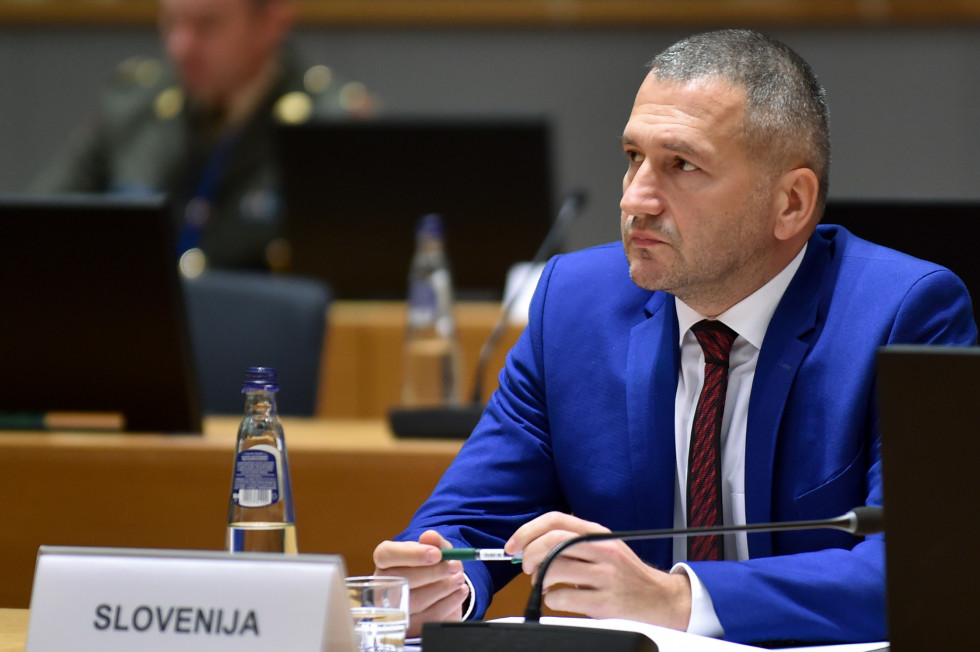EU Foreign Affairs Council meets in its defence configuration
Defence Ministers discuss missions and EU Rapid Deployment Capacity
In the beginning, the EU High Representative of the Union for Foreign Affairs and Security Policy, Josep Borrell, briefed the Defence Ministers on the EU Military Assistance Mission for Ukraine (EUMAM Ukraine), whose launch was endorsed by the Foreign Ministers yesterday. EUMAM Ukraine will be a two-year mission, without executive powers, on the territory of EU Member States, and will be exclusively dedicated to training the Ukrainian Armed Forces and not to operational tasks.
Slovenia sees the mission as a central platform for training Ukrainian Armed Forces at the European level, and, by participating in it, we will build on our existing political and diplomatic, material and financial, humanitarian, and military support, while at the same time advocating for a peaceful settlement of the conflict, emphasised State Secretary for Defence Dr Damir Črnčec. Slovenia will therefore take part in the training activities, as well as in the mission’s command and staff structures.
The ministers discussed a possible military mission to support the armed forces of Niger, as the Sahel region is of importance to the EU, in relation to both fight against terrorism and addressing of illegal migration, and the protection of human rights in the region. Concerning the EU's naval operation Atalanta, the ministers supported the possibility of transforming it into an operation to ensure maritime security.
The Defence Ministers also discussed progress toward the establishment of an EU Rapid Deployment Capability, as defined in the implementation of the Strategic Compass adopted in March this year. It is based on the revised EU Battle Group (EUBG) concept, whereby a military force of around 5,000 will be equipped with a range of different capabilities. Two operational scenarios have been drafted and will form part of the preliminary military planning, namely for rescue and evacuation tasks and for the initial stabilisation phase. The discussion was followed by a briefing on the European Commission's defence package - the new Action Plan on Military Mobility and the joint report on the EU Cyber Defence Policy.
EU Defence Capabilities
In the second, main part of the meeting, ministers discussed EU defence initiatives addressing capability development. The aim of the discussion was to find ways to make better and joint use of the existing EU defence initiatives and to bridge the gap between their implementation and the needs arising from the EU's operational commitments. Through the Strategic Compass, Member States agreed on the need to together invest more and better in capabilities and innovative technologies, to fill strategic defence gaps and to reduce technological and industrial dependence. This is why in May this year the European Commission presented a Joint Communication on the Defence Investment Gaps and proposed further measures to strengthen Europe's defence industrial and technological base. This analysis aims to help EU Member States to invest jointly in defence, including by promoting a European approach, through joint procurement of military equipment and strategic defence planning.
Ministers welcomed the work of the Defence Joint Procurement Task Force and called for a swifter harmonization of the Regulation on establishing the European defence industry Reinforcement through common Procurement Act. This will allow for the financing of mutual cooperation in the implementation of joint defence procurement. They also advocated joint projects in this field, based on the EDA's call for urgent needs for ammunition and basic military equipment. This will be followed by an enquiry for these military materiel and equipment from industry in all Member States.
Ministers agreed that the Permanent Structured Cooperation in the Field of Defence (PESCO), together with other EU defence initiatives such as the Coordinated Annual Review on Defence (CARD), the European Defence Fund (EDF) and the Capability Development Plan (CDP), is key to achieving a higher level of ambition and to bridging the gap between their implementation and the EU's operational needs. They supported a concerted effort to leverage resources and ensure synergies with NATO.
This time also on the situation in Ukraine
At a working lunch on the Russian military aggression in Ukraine, attended by NATO Secretary General Jens Stoltenberg and Ukrainian Defence Minister Oleksii Reznikov, the ministers discussed the military aspects of the war and assistance to Ukraine, including military aid. They also discussed the wider implications of Russia's illegal invasion of Ukraine and its consequences for the whole world and the region, as well as for the EU's areas of operational action, from the Western Balkans to the Eastern and Southern Neighbourhood and Africa. State Secretary Dr Damir Črnčec said that this war had brought the EU and NATO closer together and that it was important to maintain political momentum and a complementary approach. He also stressed the importance of maintaining a global focus on the consequences of the Russia’s invasion of Ukraine.
Work plan of the European Defence Agency approved
The Steering Board of the European Defence Agency (EDA) was held on the margins of the meeting. The Defence Ministers approved the EDA's budget for 2023 and the EDA's three-year action plan. They also exchanged views on the findings and recommendations of the 2022 Coordinated Annual Defence Review (CARD) report. Prior to the EDA Steering Board meeting, some Member States signed the Project Arrangement on the operational network for Military Computer Emergency Response Teams (MICNET), including Slovenia. The main objective of the MICNET Project Arrangement, in which 26 Member States intend to participate, is to promote the exchange of information and improve the response to cyber threats in EU defence structures and Member States, including those related to EU-led operations and missions.

Today’s EU Foreign Affairs Council in the defence configuration held in Brussels was attended by State Secretary for Defence Dr Damir Črnčec. | Author Svet EU

